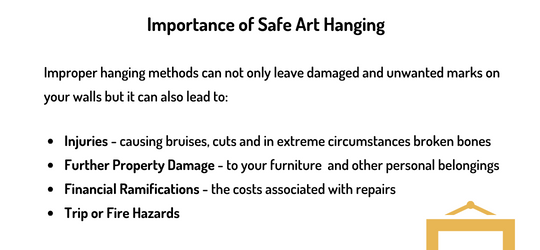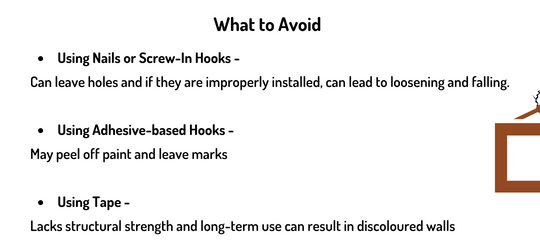Looking for a way to hang your artwork or pictures without damaging them or your walls? We’ve got expert tips to help you hang them safely and securely. Read on to find out more!
So you’ve got some pictures or artwork that would look great on your wall. The only problem is — you don’t want to put holes into your wall to hold them in place. As professional picture hangers, we’re here to share our expert advice with you so that you can display your new piece effortlessly, without worrying about them falling off or damaging the walls.
In this article, we’ve included some picture-hanging methods you should avoid, as well as the best way to hang them without damaging your walls.
Table of Contents
- The Importance of Hanging Art Safely
- Picture Hanging Methods to Avoid
- The Best Way to Hang Pictures Without Damaging Walls
The Importance of Hanging Art Safely

Art comes in different shapes and sizes, from quaint 1×1 frames, to sprawling canvases that can span an entire wall. When displaying art in homes, many people opt to hang them on the walls to utilise the empty space.
However, big or heavy artwork can often prove a challenge to hang due to the potential danger of falling down, damaging furniture, or hurting others as a result. Holding these large artworks up using nails is the most obvious solution, but it’s also one that leaves unsightly holes in the walls.
Furthermore, those living in rentals or strata won’t have the luxury of hammering nails into the wall to hang artwork or pictures due to the lasting damage it will have on the wall.
Picture Hanging Methods to Avoid
If you’re looking to hang your pictures or artwork without any damage to the walls, we recommend avoiding these few methods:
Nails or screw-in hooks
Using nails or screws as anchor points for hanging art can work, but they leave holes and damage on your wall that can potentially lead to long-term maintenance issues and frequent repairs. If not installed properly, some nails or screws can also come loose from the wall and cause your artwork to fall unexpectedly and become damaged.
Wall hooks that you can find at Bunning while more sturdy than individual nails, often require screws or nails to hold them securely into place, resulting in the same wall holes and damage to your walls.

Adhesive-based hooks
Avoid using adhesive strips for hooks. The adhesive material can often peel off paint or leave residual marks after a prolonged period of time, resulting in cosmetic damage to the wall. Adhesive strips also vary in strength and holding power, making them rather unreliable options for hanging heavier, high-value pieces of artwork.
Tape
Tape is perhaps the most unreliable tool for hanging pictures and artwork. Due to its flexibility, it does not have the structural strength to support frames for artwork or pictures.
Tape is also notorious for peeling and discolouring wall surfaces, which results in the need for repairs and paint jobs to cover up blemishes and damage, especially in a rental property.
The Best Way to Hang Pictures Without Damaging Walls
So, what is the best way to hang pictures without damaging your walls?
At Professional Picture Hanging, we make use of a specialised hanging system to hang pictures and artwork seamlessly without any damage to walls. Our picture rails are easily removable and customisable to fit any wall material, from gyprock to brick, or even concrete.
We can mount your picture and artwork securely and safely on your walls, regardless of their size or weight. Plus, our picture-hanging services include placement recommendations to display your artwork for the most stunning results.
If you live in a rental property and are not able to drill into the walls, we recommend booking us in to remove the hanging hooks and fill the holes with plaster when you are moving out.
Contact our team today to find out how we can help you hang your artwork securely and safely without damaging your walls!
